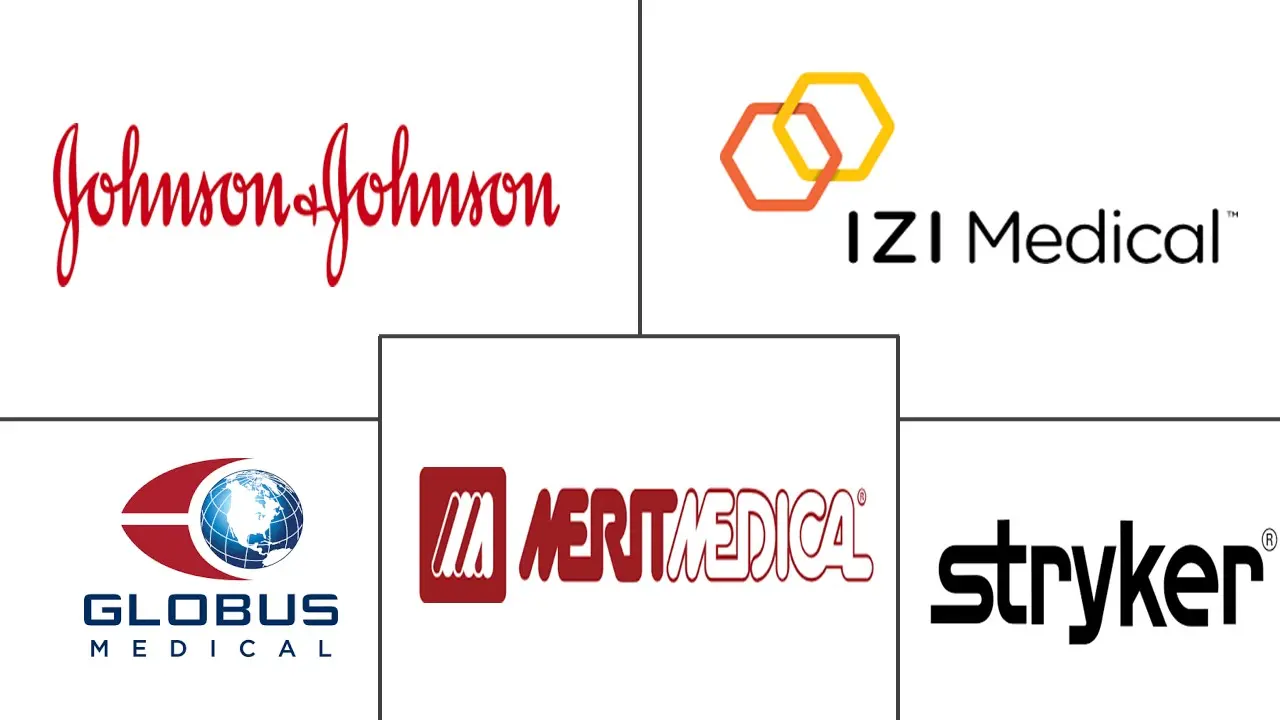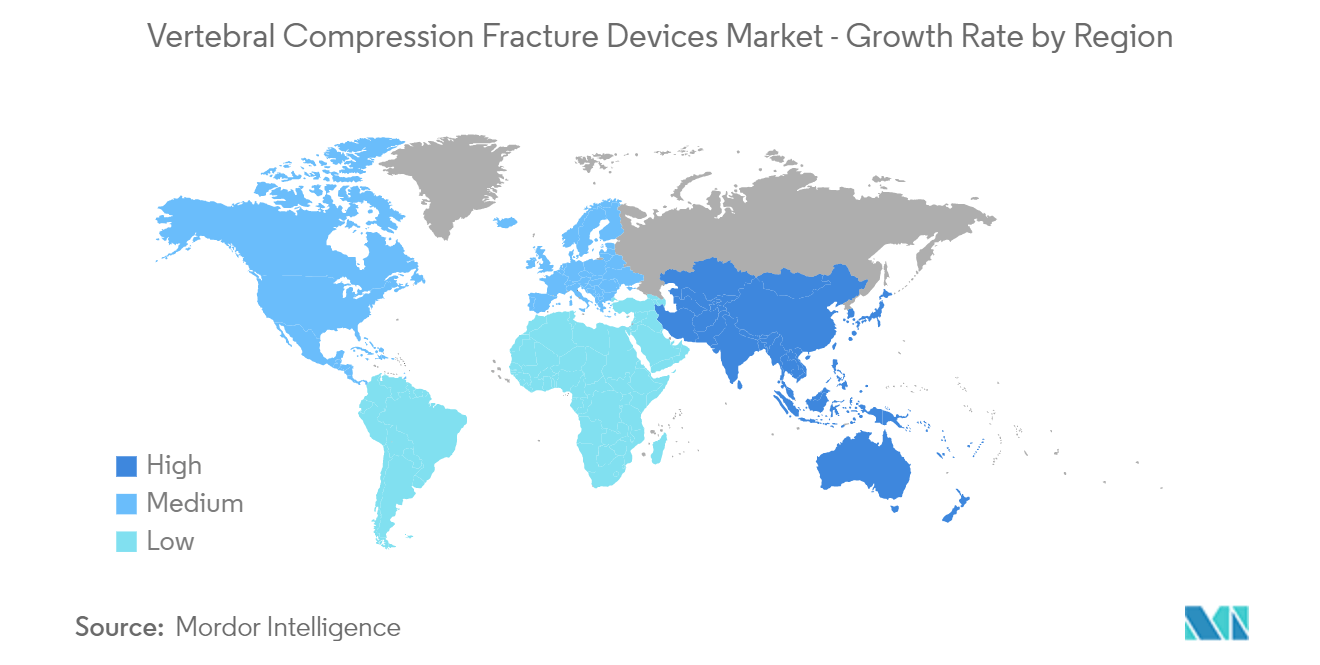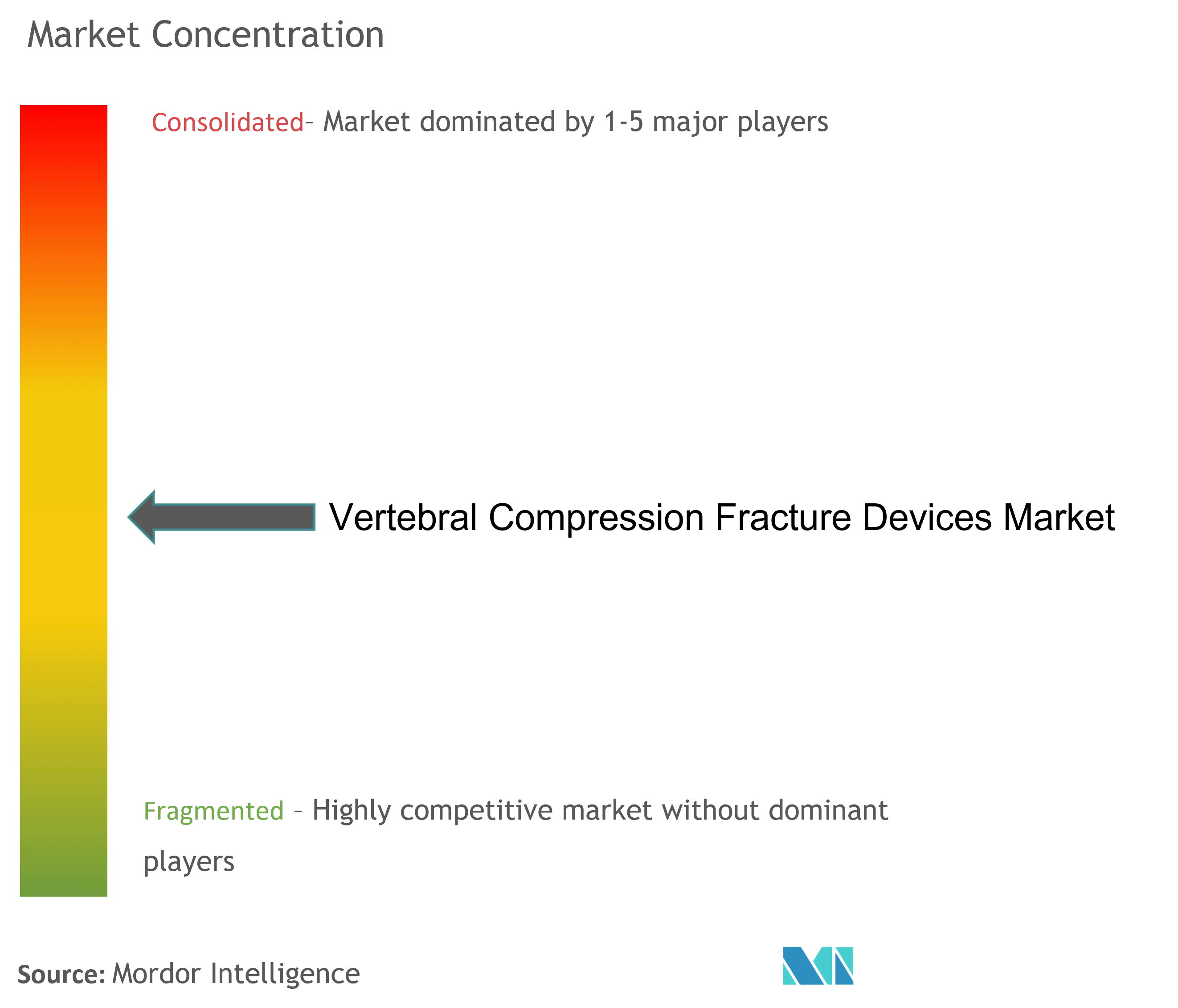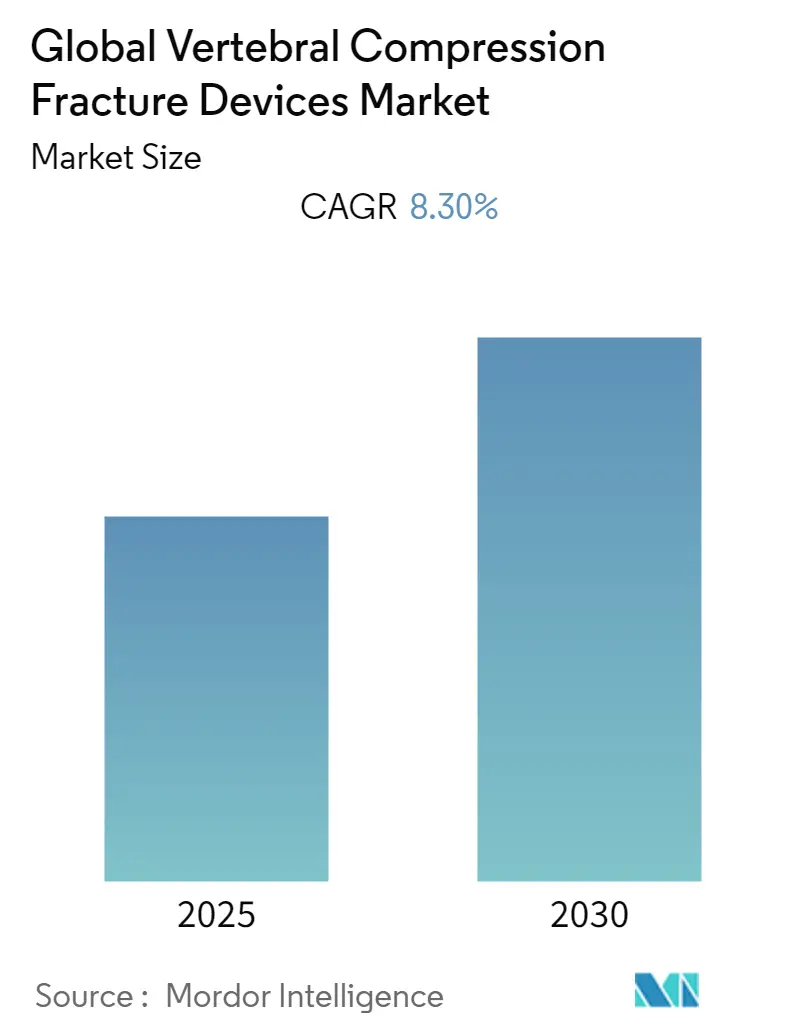
Vertebral Compression Fracture Devices Market Analysis
The Global Vertebral Compression Fracture Devices Market is expected to register a CAGR of 8.3% during the forecast period.
COVID-19 significantly impacted the vertebral compression fracture devices market during the pandemic due to the shift of focus towards battling COVID-19 infection and the decrease in spine surgeries. For instance, according to the study published by World Neurosurgery in September 2021, in Central Europe, the COVID-19 pandemic resulted in limiting regulations for spinal surgery units. Elective surgical operations were decreased, allowing more resources to be allocated to patients with severe acute respiratory coronavirus infections. However, surgical wait times increased due to the pandemic restrictions, which is expected to increase the demand for spine surgeries during the post-pandemic period. Hence, the increased spine surgical wait time is expected to increase the demand for vertebral compression fracture devices and likely propel the growth of the market over the coming period.
The major factors driving this market include the growing burden of osteoporosis and arthritis, the rising burden of trauma and cancers, increase in awareness about the advancements in spinal surgeries and minimally invasive surgeries, among others.
According to the study published in the Journal of Orthopaedic Surgery and Research in October 2021, the global prevalence of osteoporosis was estimated to be 18.3 %. The global prevalence of osteoporosis in women was found to be 23.1%, and in males was found to be 11.7%. People between the ages of 18 and 95 were found to have the highest frequency of osteoporosis. As osteoporosis patients are prone to vertebral compression fractures by simple daily activities, the market is expected to drive due to the huge burden of osteoporosis due to the rise in the adoption of vertebral compression fracture devices.
Furthermore, new research studies on the higher restoration of fractures by the use of vertebral compression fracture devices are expected to drive the market. For instance, as per the study report published by Dovepress in August 2022, if a fractured vertebral body had dynamic mobility, the use of a balloon during balloon kyphoplasty could provide more kyphosis correction, higher vertebral body height restoration and lower cement leakage rate than percutaneous vertebroplasty. These studies help in the widespread usage of various vertebral compression fracture devices, which is expected to drive the market over the forecast period.
Thus, the aforementioned factors, like new research studies and the high prevalence of musculoskeletal disorders are expected to increase the demand for vertebral compression fracture devices that boost the market to growth over the study period. However, risks associated with post-surgical complications, including hemorrhage, vertebral posterior element fracture, and stringent regulatory approval for the devices, and reimbursement issues, are expected to hamper the market growth.
Vertebral Compression Fracture Devices Market Trends
Minimally Invasive Spine Surgery Segment is Expected to Hold a Significant Share Over the Forecast Period
Minimally invasive spine surgery (MIS) often aims to stabilize the vertebral bones and spinal joints and relieve pressure on the spinal nerves. The minimally invasive spine surgery segment is likely to hold a significant market share, and it is expected to continue the same over the forecast period owing to the increased adoption of minimally invasive surgical procedures and the rising burden of spine injuries due to accidents or trauma, or cancers.
Furthermore, as per the Spinal Cord Injuries book data updated in August 2021, the leading cause of spinal cord injury (SCI) is motor vehicle collisions which accounts for 38% of new SCI each year, 30% of SCI are due to falls, 13% due to violence, 9% from sports injuries, and 5% from medical and surgical etiologies in the United States.
The increasing research funding or initiatives in the segment helps to drive the market over the study period. For instance, in September 2022, RevBio, Inc. was awarded a Phase I Small Business Innovation Research (SBIR) grant from the National Institute on Aging, part of the NIH. This funding allows the company to pursue the treatment of vertebral compression fractures with its patented bone adhesive technology known as Tetranite, which be delivered in a minimally invasive procedure. Hence, the new research grants or fundings increase the adoption of minimally invasive spine surgery, which is expected to drive the growth of the market through this segment.
The rise in initiatives by the market players in the vertebral compression fracture devices market is expected to drive this segment's growth further. For instance, in September 2021, Medtronic introduced three new devices to its minimally invasive spinal technologies ecosystem, making it the company to combine spinal implants, biologics, navigation, robotics, and AI-powered data for surgeons and patients. Such initiatives by the key players in spine surgical devices are therefore expected to drive the growth of this segment over the forecast period.
Thus, all the above-mentioned factors, like rising spinal injuries, increasing research funding or initiatives, and rise in initiatives by the market players, increase the demand for products in the segment and are expected to boost the market to grow.
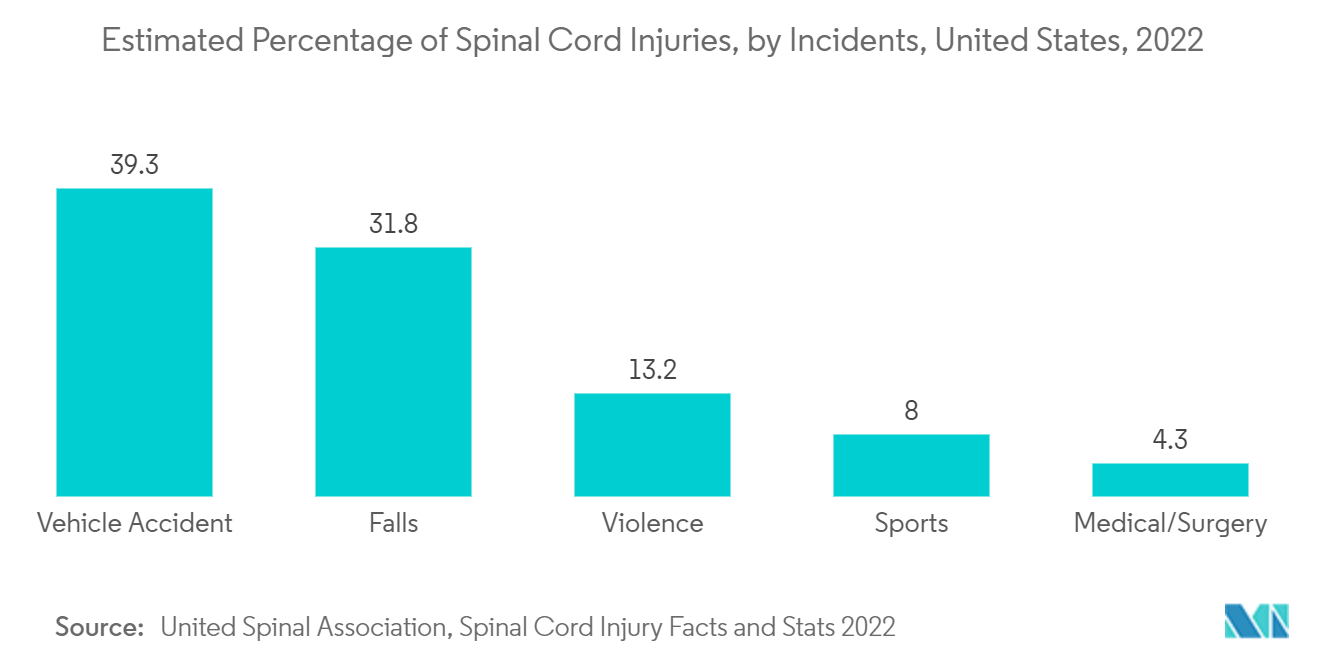
North America is Expected to Hold a Major Share in the Market Over the Forecast Period
North America is expected to hold a major share of the market, and it is expected to do the same over the forecast period. The factors owing to the growth of the market in this region include advancements in minimally invasive surgeries, the rise in prevalence of target diseases, the rise in research funding for trauma-related head and spine injuries, strong foothold of key market players, among others.
Accidental injuries in Mexico are the major factor for vertebral fractures, which increases the demand for vertebral compression fracture devices. For instance, according to GNP Insurance 2022, the number of car accident injuries grew by 28% in 2021 compared to the previous year in Mexico, which increases the demand for vertebral compression fracture devices and is expected to drive the market over the forecast period.
The rising initiatives of key market players are also expected to propel the market growth in this region over the forecast period. For instance, in August 2021, Vertefix HV Cement, a unique solution that addresses the need for real-time flow visualization during cement injection for vertebroplasty and kyphoplasty procedures, was launched by IZI Medical Products LLC. Such initiatives will lead to increased adoption of vertebral compression fracture devices along with the adoption of cement, driving market growth in the United States.
Thus, all the aforementioned factors, like increasing accidental injuries and initiatives by market players, increase the usage of market-specific products that boost the market over the forecast period.
Vertebral Compression Fracture Devices Industry Overview
The vertebral compression fracture devices market is moderately competitive. The market is expected to drive due to the rise in product launches by the key market players and the rise in partnerships, mergers, and acquisitions among the market players, among others. Some of the key players in the market include Spirit Spine Holding Corporation Inc, IZI Medical Products, Stryker Corporation (Orthovita, Inc.), Orthofix Interventional N.V., Johnson & Johnson (DePuy Synthes), Globus Medical, Inc., and Merit Medical Systems Inc., among others.
Vertebral Compression Fracture Devices Market Leaders
-
IZI Medical Products
-
Stryker Corporation
-
Merit Medical Systems Inc.
-
Globus Medical, Inc.
-
Johnson & Johnson (DePuy Synthes)
- *Disclaimer: Major Players sorted in no particular order
Vertebral Compression Fracture Devices Market News
- April 2022: Hyprevention, a French company, raised USD 4.5 million for vertebral implant development in the United States to roll out its STRUTPLASTY platform in the country.
- January 2022: SetBone, a company that developed a novel bone cement for the treatment of spinal vertebrae fractures and other orthopedic procedures, closed an oversubscribed investment round of USD 1.6 million.
Vertebral Compression Fracture Devices Industry Segmentation
As per the scope of this report, vertebral compression fractures (VCFs) are caused by the collapse of the bone block or vertebral body in the spine, resulting in severe pain, deformity, and loss of height. These fractures are more prevalent in the thoracic spine (the middle section of the spine), particularly in the lower section. The vertebroplasty procedure involves placing medical cement in the damaged vertebral body to provide immediate pain relief and stability. Kyphoplasty, on the other hand, involves the equipment for creating a cavity underneath the broken vertebral body and injecting medical-grade bone cement into the cavity. The Vertebral Compression Fracture Devices Market is segmented by Product Type (Balloon Kyphoplasty and Vertebroplasty), Surgery (Open Spine Surgery and Minimally Invasive Spine Surgery), End-User (Hospitals, Ambulatory Surgical Centers, Trauma Centers, Others), and Geography (North America, Europe, Asia-Pacific, Middle East and Africa, and South America). The market report also covers the estimated market sizes and trends for 17 different countries across major regions globally. The report offers the value (in USD million) for the above segments.
| By Product Type | Balloon Kyphoplasty | ||
| Vertebroplasty | |||
| By Surgery | Open Spine Surgery | ||
| Minimally Invasive Spine Surgery | |||
| By End User | Hospitals | ||
| Ambulatory Surgical Centers | |||
| Trauma Centers | |||
| Others | |||
| Geography | North America | United States | |
| Canada | |||
| Mexico | |||
| Europe | Germany | ||
| United Kingdom | |||
| France | |||
| Italy | |||
| Spain | |||
| Rest of Europe | |||
| Asia-Pacific | China | ||
| Japan | |||
| India | |||
| Australia | |||
| South Korea | |||
| Rest of Asia-Pacific | |||
| Middle East and Africa | GCC | ||
| South Africa | |||
| Rest of Middle East and Africa | |||
| South America | Brazil | ||
| Argentina | |||
| Rest of South America | |||
Vertebral Compression Fracture Devices Market Research FAQs
What is the current Global Vertebral Compression Fracture Devices Market size?
The Global Vertebral Compression Fracture Devices Market is projected to register a CAGR of 8.3% during the forecast period (2025-2030)
Who are the key players in Global Vertebral Compression Fracture Devices Market?
IZI Medical Products, Stryker Corporation, Merit Medical Systems Inc., Globus Medical, Inc. and Johnson & Johnson (DePuy Synthes) are the major companies operating in the Global Vertebral Compression Fracture Devices Market.
Which is the fastest growing region in Global Vertebral Compression Fracture Devices Market?
Asia-Pacific is estimated to grow at the highest CAGR over the forecast period (2025-2030).
Which region has the biggest share in Global Vertebral Compression Fracture Devices Market?
In 2025, the North America accounts for the largest market share in Global Vertebral Compression Fracture Devices Market.
What years does this Global Vertebral Compression Fracture Devices Market cover?
The report covers the Global Vertebral Compression Fracture Devices Market historical market size for years: 2019, 2020, 2021, 2022, 2023 and 2024. The report also forecasts the Global Vertebral Compression Fracture Devices Market size for years: 2025, 2026, 2027, 2028, 2029 and 2030.
Our Best Selling Reports
Global Vertebral Compression Fracture Devices Industry Report
Statistics for the 2025 Global Vertebral Compression Fracture Devices market share, size and revenue growth rate, created by Mordor Intelligence™ Industry Reports. Global Vertebral Compression Fracture Devices analysis includes a market forecast outlook for 2025 to 2030 and historical overview. Get a sample of this industry analysis as a free report PDF download.

